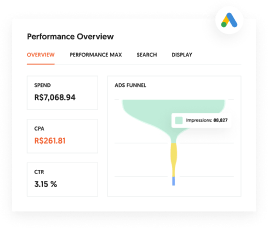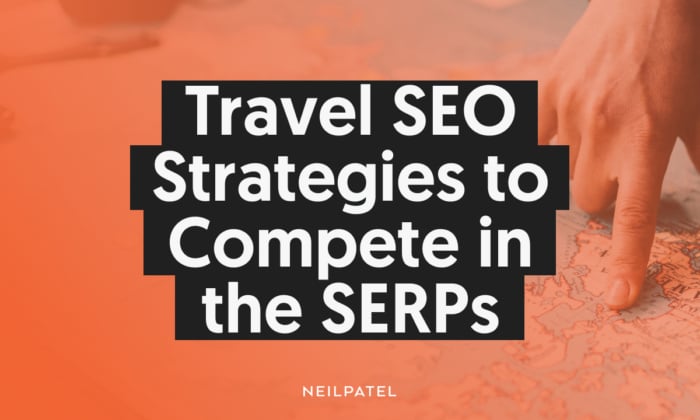
Are you looking to increase traffic to your travel website? Then, you might as well get a piece of the pie.
The travel industry is lucrative, and the competition is fierce. Therefore, rival businesses in this space need to ensure an effective travel SEO strategy to remain competitive and drive more customers.
Travel SEO helps websites become more visible in search engine results pages (SERPs) when implemented effectively. In addition, there are multiple strategies you can introduce to bolster the SEO for your travel website.
In this article, I’ll discuss proven strategies for improving travel SEO and competing in the SERPs.
SEO Tips for The Travel Industry
There are many aspects to travel SEO that overlap with typical SEO, such as keyword research, building backlinks, and optimizing your images.
However, some unique challenges face the travel sector. For example, most people use general search terms and keywords to find travel information and rarely convert on the first visit. This means there are a lot of potential keywords to focus on and strategies required to get repeat visits.
Internal linking is also an issue. As Antoine Eripret from the French travel metasearch engine, Liligo.com told Botify:
“Sometimes search volume is higher on more specific queries (for example, “flight to London” can have less search volume than “Paris to London”), and for internal linking, it becomes difficult to know where to link, with so many origins and routes to cover, you can’t include links to them all on the homepage, for example.”
However, let’s put some of those obstacles aside for now.
First, I’ll provide some tips on how to use travel SEO keywords to improve the performance of your travel industry website.
1. Know Your Keywords
Creating an effective keyword list is essential for successful search engine optimization (SEO). To get started, list relevant words that describe what you do. For example, include words related to your travel business’s services or products.
You can begin your keywords with Ubersuggest, and don’t overlook long tail keywords as they’re imperative to your travel SEO. For instance, you might want to focus on search terms like ‘family vacation packages’ or ‘luxury hotel rooms’.
You should also consider inserting location-specific keywords, such as ‘Miami beach resort’ or ‘New York City tour guide’.
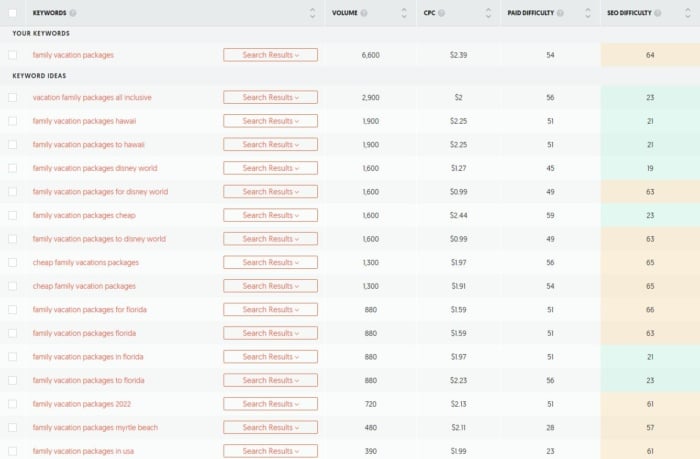
In addition, take time to do some competitive analysis so you can assess keyword search volumes.
When you’ve compiled your list, add these keywords to:
- Blog posts
- Meta descriptions
- Social media
- URLs and website
- Online profiles and directories (like Google Business Profile and Yelp, etc.)
That’s a brilliant start, but you need to know how to use keywords strategically to get results.
2. Use Your Keywords Strategically
Keywords are great for attracting organic travel SEO. However, that doesn’t mean you don’t need a strategy behind them.
By changing your keyword strategy to meet seasonal demands, user intent, and the customer journey stage, you’ve got a better chance of grabbing the attention of consumers who want what you’re offering.
Let’s look at some examples.
A couple may be looking for a Valentine’s Day break, but they’re undecided on the destination. So rather than search for a specific location, they might search for something along the lines of:
‘Romantic break in New York’ or ‘Valentine’s weekend break in New York City’. Adding long-tail keywords to your blog content can attract the right type of customers.
Aside from targeting seasonal searchers, you should also create content around the customer journey stage.
Someone planning a vacation goes through the same stages as other consumers: awareness, research, and buying.
However, you could describe it another way. Adido’s customer journey map looks like this:
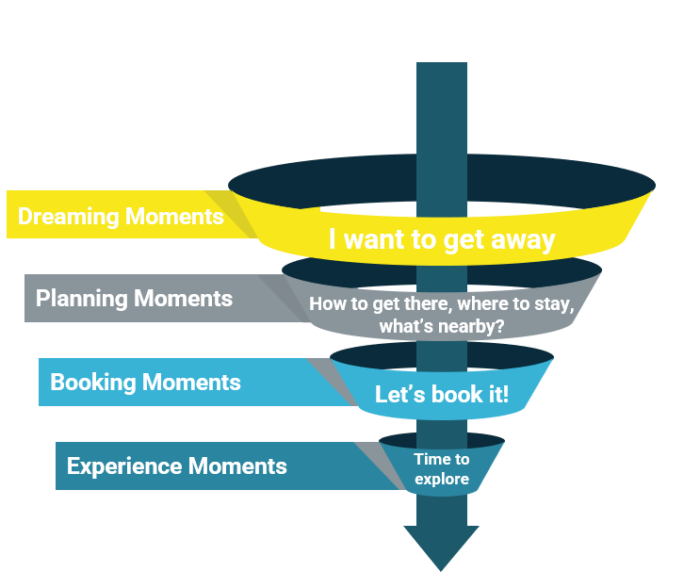
Dreaming moments: These are when the tourist is in the early stages of the journey and hasn’t got any concentrated plans. For this stage, you’d want to use long tail keywords, the same way you would with our Valentine’s example.
Planning moments: At this point, the searcher has a destination in mind, so your content should match that intent. For instance, perhaps they’ve decided on New York. So you’d concentrate on local SEO, tourist attractions, eating establishments, and events and cover them in your blogs.
Booking moments: This is the buying stage when you’ve successfully convinced the searcher to book with you.
Experience moments: This is where you drill down and focus on things to see and do in a specific location.
3. Build Local Landing Pages
Local landing pages are carefully targeted for each city or region you serve. These web pages provide targeted information about your services in the local area and help draw in customers interested in what you offer.
Creating these pages enables you to target specific keywords related to each location and improve your search engine rankings. This means more potential customers can find out about your business and have easy access to the information they need when deciding on their next vacation destination.
This is the approach Booking.com takes with its landing page, targeting tourists by location and accommodation types.
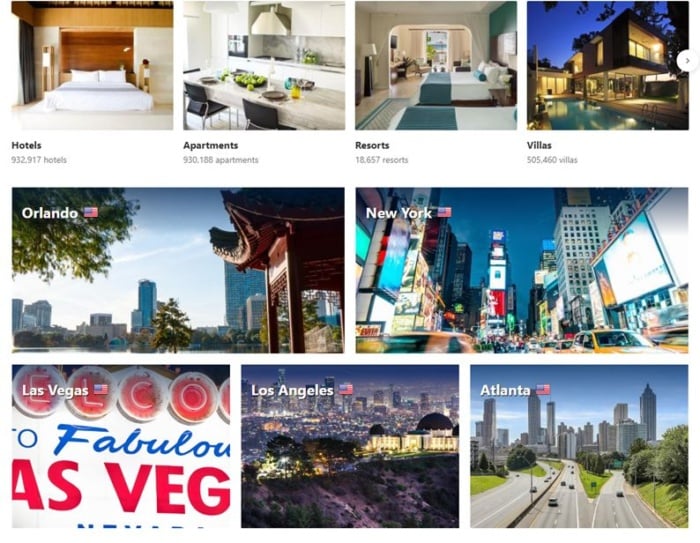
Now you know what a landing page can do for your travel SEO, let’s move on to structured data.
4. Use Structured Data
Using structured data for travel SEO provides many benefits, like improved visibility and more click-throughs.
Additionally, adding schema markup gives Google some context, and when the search engines understand your content, the more likely it’s to feature in rich snippets.
There are lots of different types of structured data out there, and many of them provide more insights in the SERPs. Some common examples are:
- FAQ schema for blogs
- Review schema for product pages
- Video schema to make your video content more crawlable
- Price schema for any product pages you have.
While many brands don’t use rich snippets, the benefits are undeniable. Displaying more valuable and interesting information prominently and visually can help you stand out from the competition and attract more visitors to your site.
Using structured data can also help to grow your organic traffic. For example, when Search Engine Journal implemented structured data for a client, it yielded a 400 percent net growth in rich result traffic.
Additionally, other brands experienced a 160 percent growth in impressions and a 150 percent increase in clicks.
Finally, another company had a 41 percent increase in impressions and a 28 percent increase in clicks.
Want a boost in your travel SEO? I can’t guarantee you results like the above, but there are several types of structured data you could use, like:
- Rates
- Accommodation type
- Airlines
- Tour operators
If you need a detailed tutorial on adding schema, click the link above.
5. Update Your Google Business Profile
Your Google Business Profile is one of the most important pieces of your online presence, and it’s free. When you set up a profile, you can personalize your page with your latest images and offers while adding posts with content designed to attract your prospects.
However, as with your travel SEO, it’s not a one-off task; it takes time and effort. With more and more travelers relying on search engines for their trips, optimizing your GMB profile is one of the keys to success in the travel market.
Additionally, you can use GBP for:
- Adding reviews and rankings
- Writing posts
- Adding map directions
- Creating videos and sharing them on social media
- Using local SEO to optimize your profile
With images, remember to include alt tags and limit picture size for easy loading. The recommended image size for GBP posts is 1200 x 900 pixels if it’s direct from the GBP dashboard, along with a 4:3 ratio.
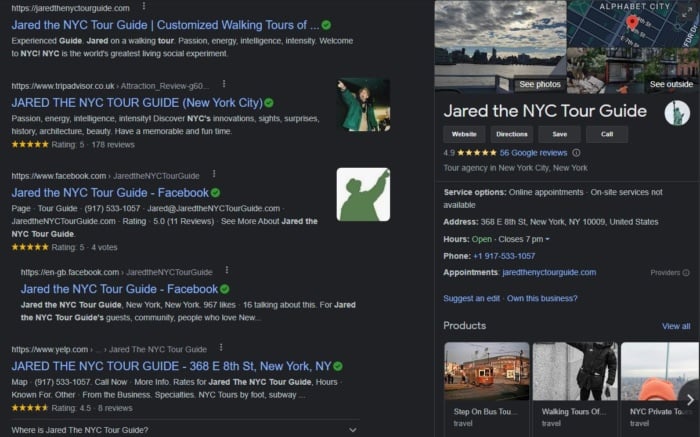
As a side note, if your business has multiple locations, be sure to create a Google Business Profile for each location.
6. Use Event Schema
Event schema is an effective way to improve your travel SEO. With this type of schema markup, you can give search engines more information about events related to your business, such as upcoming conferences or festivals. This helps search engines better understand the content on your website and improve how it ranks in SERPs (search engine result pages).
Using event schema has multiple benefits, such as:
- Enhanced click-through rates
- Increased traffic
- Voice search optimization
Schema might sound complicated, but it’s easy enough to set up. Go to Google’s Structured Data Markup tool and select ‘events’ from the menu.
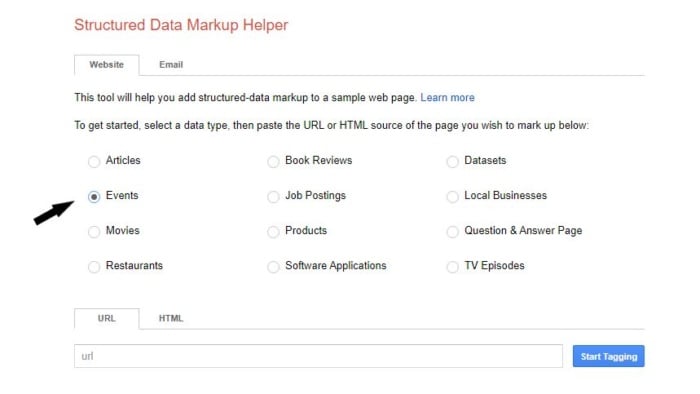
From there, choose the URL of the page you want to tag or the raw HTML and begin!
Highlight areas with relevant info on the page like relevant dates, locations, and the event name, then press create HTML. You now have all the code you need for your event schema.
7. Audit Your Existing Presence
A comprehensive audit of your website and content can help you identify areas that need improvement to gain a competitive advantage.
During an audit, you need to look at four main areas:
- On-page SEO (optimizing individual web pages to enhance search engine rankings and visibility. It involves adding keywords to page titles, meta tags, heading tags, etc., including image alt text and adding meta descriptions).
- Off-page SEO (the efforts you make offsite to improve SERPs, including building backlinks, writing guest posts, and social media shares).
- Technical SEO (measures you make on your site to improve crawling and indexing.
- Local SEO (helps businesses to get higher up in the SERPs and increase visibility, traffic, and lead generation from local customers. It involved using methods like optimizing your GBP and using local themed keywords, for instance, ‘New York cafe’).
When auditing, key areas to look at are:
- Canonical tags
- Increasing page speed
- Meta descriptions
- Mobile-friendliness
Additionally, check that each page has one H1 tag and include keywords within the H1 so that search engines can better understand the content. Furthermore, look for duplicate content or pages with thin content since these could negatively affect rankings.
Finally, analyze your backlink profile to ensure links from trustworthy sources are pointing toward your site.
8. Maintain Your Reputation
Your online reputation is everything. The more positive your reviews are, the more likely holidaymakers will book with you.
Maintaining your reputation can also have a positive impact on your travel SEO. The more detailed your reviews are, the more likely Google will consider you an authority, which can help build backlinks. Also, potential buyers can learn more and be inspired to take action from a well-written review.
In addition to setting up a Google Business Profile, you could sign up with Yelp, TripAdvisor, or Facebook.
However, it’s not just important to get reviews; it’s also vital you manage your reputation. That means monitoring what people are saying about you. Take some time each week to search for any content related to yourself or your business. A proactive approach to responding to reviews, positive or negative, can work wonders for consumer confidence.
9. Create Quality Content
Eight out of ten marketers prioritize content creation, and rightly so. Consistently producing quality content:
- Gives you more opportunities to rank in the SERPs through keyword integration
- Establishes and maintains your authority.
- Provides more chances for backlinks
- Creates trust
What kind of content would work well for travel SEO? Well, blogging is the most obvious one, but there are other types like:
- Social media
- Case studies
- Video content
- Images
Don’t overlook the power of user-generated content(UGC), though. There are few things more valuable than reviews; when happy customers can’t wait to share their images and thoughts, Google takes notice, and so do potential buyers.
Why not launch a competition and invite past customers to share pictures/videos? You can offer a small prize or discount and use the content on your website or social media pages. Or you could create a forum dedicated to travel in one area, where travelers can share helpful advice. Here’s an example from Trip advisor for New York City.

10. Repeatedly Optimize Your Site for Improvements
Like SEO and filling out your online profiles, once isn’t enough.
Regularly auditing and optimizing your website is essential for improving user experience and keeping up with the ever-evolving search engine algorithms. It’s a process that you should repeat regularly, as it can help you identify problems, areas of improvement, and opportunities to capitalize on.
When conducting an audit, it’s essential to consider all aspects of your website, like speed, performance, content optimization, and link building.
In addition, you should also review your analytics data to determine how visitors interact with your site. By taking the time to consider this information, you can better understand how changes can improve engagement levels, boost SEO rankings, and increase conversions.
11. Track Your Analytics
You can identify areas that need improvement and develop strategies to better reach potential customers by analyzing key data points such as page visits and search engine rankings. Additionally, carefully monitoring your website’s performance over time makes it possible to understand better how web design or content changes affect user experience.
If you need a free tool, try Google Analytics to view the following:
- Engagement rates
- Traffic rates
- Urchin Traffic Modules (UTMs). These URL parameters give web admins more significant insights into website traffic. By adding UTM codes to the end of URLs, web admins can track where visitors originate from and how they interact with their website).
You’ll also want to track unique page views, referral sources, average time spent on specific pages, and the total number of visitors from a particular geographic location.
With these metrics, you can understand how users interact with your website and what features they find most useful. This data will help refine your marketing strategy and create more targeted campaigns.
12. Focus on Link Building
Efficient link building is essential for travel SEO.
Using backlinks from other websites to your own can help boost rankings on search engine results pages. By creating links from popular, authoritative web pages to your website, you can increase the visibility and relevance of your travel site in search engine queries.
This could include content such as blog posts, reviews, interviews, or influencer collaborations that build trust and demonstrate expertise in the field of travel.
Building links may seem like a challenge, but it works.
According to AuthorityHacker, 79.7 percent of SEOs consider link-building a vital part of their strategies.
In addition, 78 percent of CEOs say they get a positive impact and ROI from link building.
To build links:
- Issue press releases about special offers, contests, etc.
- Line up interviews with magazines and podcasters
- Create ‘ultimate guide’ style posts
- Develop image-rich content for easy sharing and use the power of social media to promote it.
- Release eBooks with travel tips and travel guides
- Write guest posts
For example, a guest blog post would look something like this.
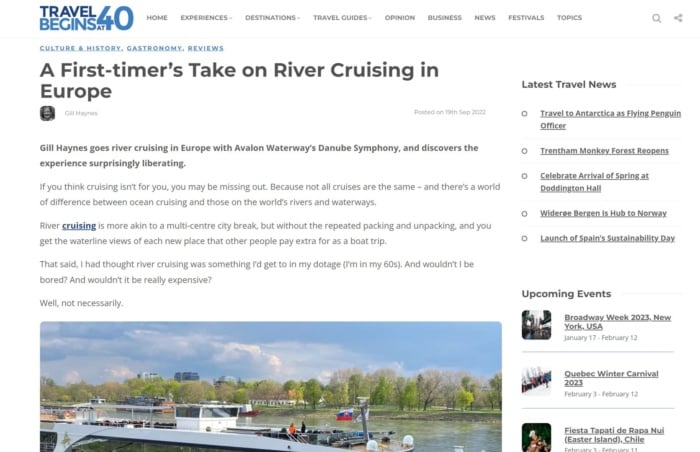
Next, let’s move on to image optimization.
13. Optimize Images
Properly optimizing images makes your website more likely to appear higher in search results.
Below are some tips to get the most from your pictures.
- Ensure that your images are SEO-friendly. This means including an appropriate alt image tag and alt text with each one; adding relevant keywords when possible.
- Include high-quality images and remove distracting elements like watermarks or low-resolution issues.
- Consider creating an image sitemap. Image sitemaps give search engines more information and assist the search engines in crawling your site.
- Compress images to increase page speed.
- Use responsive design to cater to users on a range of devices.
14. Utilize Social Media
Social media provides an efficient platform to reach potential customers and engage with them personally. It can help you develop relationships with customers and strengthen brand loyalty. Social media can also increase page engagement, provide backlinks, and improve brand presence.
Naturally, social media has become a popular way for travel companies to promote their businesses, with Facebook remaining the favorite.
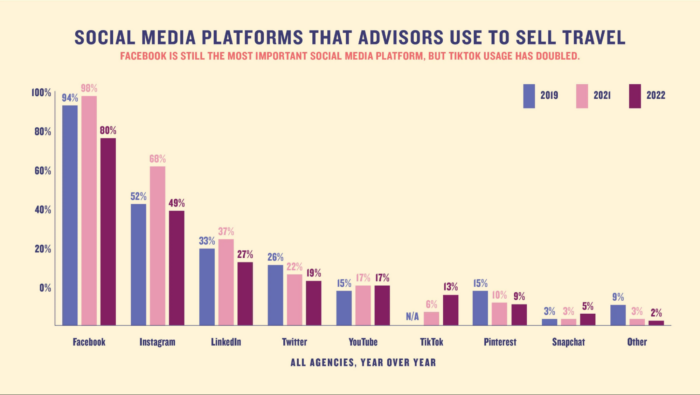
Creating content focusing on local attractions and events is an effective way to drive engagement with your followers. This could be anything from public festivals and art galleries to food tours and adventure activities.
You could also take some tips from Booking.com. As part of its strategy, Booking.com:
- Uses storytelling through articles and helpful tips and shares its content on social media
- Posts videos on YouTube
- Regularly posting content on different social media sites
- Publishing a range of content
- Posting geographical content
- Makes excellent use of hashtags
- Creates shareable memes
Booking.com also tailors its content according to the social media site and users’ preferences.
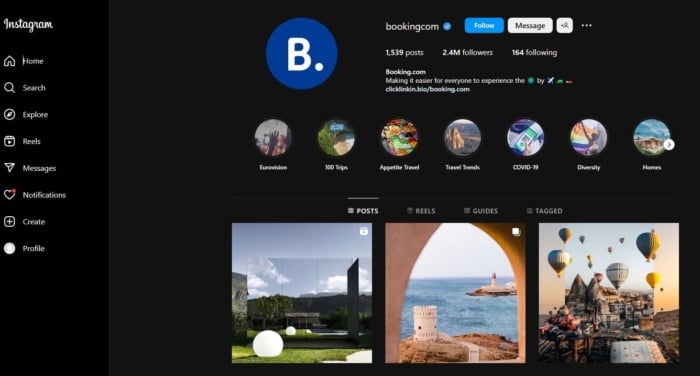
FAQs
SEO in tourism means optimizing online content to rank higher on the SERPs. It involves using keywords, link building, and other techniques to ensure your website or blog appears prominently when people look for information related to your business, in this case, the travel industry.
The travel industry is a highly competitive landscape, with companies vying for customers’ attention worldwide.
SEO helps travel companies get more visibility on search engine results pages (SERPs) and increase website traffic.
Additionally, SEO increases customer engagement and loyalty by making websites more visually appealing and easier to navigate. Through targeted campaigns like local SEO or content marketing, brands can connect with travelers looking for certain services or destinations online, potentially leading to higher customer conversions.
You can take some simple steps to improve your travel business’s visibility on Google and other major search engines.
Do keyword research, use those keywords strategically throughout your articles, work on building backlinks, add schema markup, and publish helpful content on topics relevant to your target audience.
Conclusion
SEO for your travel blog or site doesn’t have to be complicated. Just follow the above SEO tips, and the hard work should start paying off in time.
A well-crafted SEO strategy allows you to work smarter, not harder, to bring in new business while keeping existing customers loyal.
By utilizing the right strategies, you can ensure your website stands head and shoulders above your competition in the SERPs.
Don’t be phased by thinking it’s a difficult task. Instead, begin by introducing a few steps at a time like keyword research, writing content that matches search intent, and leaving the technical side to an agency if you want to.
Have you used any of these travel SEO strategies? Share the details below.

See How My Agency Can Drive More Traffic to Your Website
- SEO - unlock more SEO traffic. See real results.
- Content Marketing - our team creates epic content that will get shared, get links, and attract traffic.
- Paid Media - effective paid strategies with clear ROI.
Are You Using Google Ads? Try Our FREE Ads Grader!
Stop wasting money and unlock the hidden potential of your advertising.
- Discover the power of intentional advertising.
- Reach your ideal target audience.
- Maximize ad spend efficiency.

